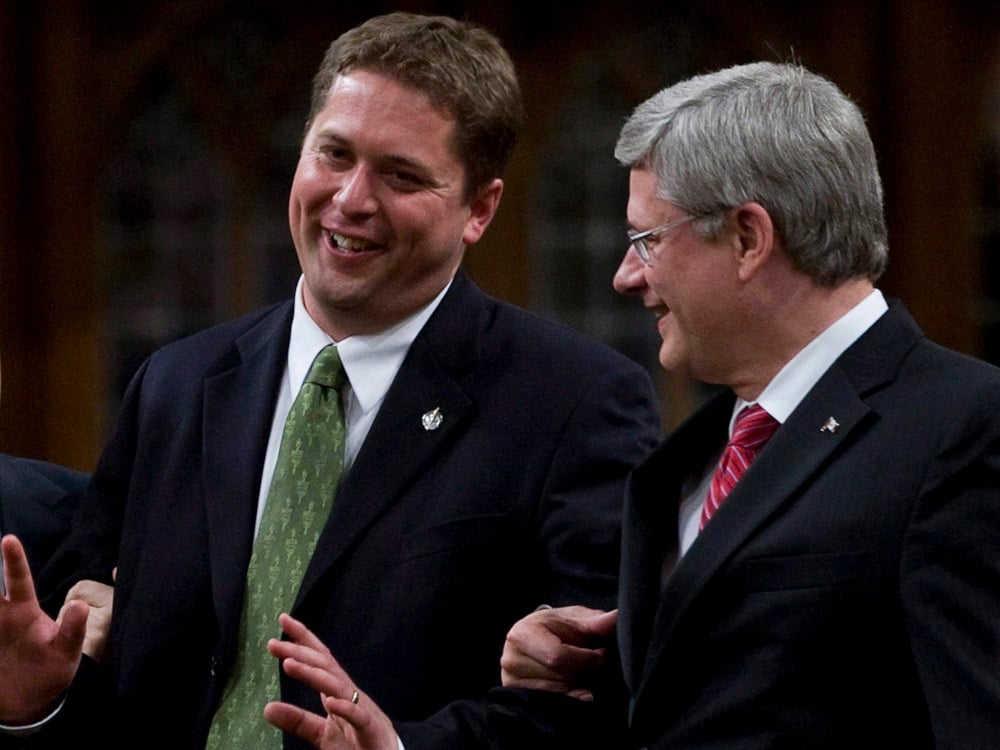All the ways he’s campaigned for leader almost as soon as Scheer won.

Laughing and waiting? Former Tory PM Stephen Harper has sent many signals he wants back in the role of Conservative leader. Photo by Adrian Wyld, the Canadian Press.
For months now, sources within the Conservative party have been telling me of an internal faction eager to see Andrew Scheer gone in order to make way for the return of Stephen Harper as party leader.
Nothing we’ve seen in recent weeks, and now today, argues against this. In fact, Scheer’s doomed attempt to hang on to the CPC leadership has been like watching a puppy running around on a six-lane highway. And now he’s roadkill.
So who might be next up? As the Christmas ditty goes, it’s beginning to look a lot like Harper, everywhere you go.
As one Senator put it to me on background, “While the avalanche of criticism mounts, no one is talking up a successor. Who is waiting in the wings, ready to go, straight out of the box? Only one person is ready. Stephen Harper, come on down!”
It may not be as glitzy or cut and dried as that. There are certainly other leadership assets within the CPC, including Lisa Raitt, Michael Chong, Peter MacKay, Erin O’Toole, and Rona Ambrose.
Each of them might be able to move the party closer to millennials, urban voters, and environmentalists — if that is where the CPC decides it needs to go in pursuit of power. A speculation, by the way, that is far from a sure bet.
But each also has their fair share of drawbacks.
Raitt, Chong, and O’Toole were rejected by Conservatives in the 2017 leadership race — and then Raitt went on to lose her seat in parliament in the recent election.
MacKay is blamed by some for betraying the old Progressive-Conservative party when the CPC was created. The PCs were submerged by, rather than merged with, the Canadian Alliance led by Harper.
Although Ambrose got good reviews for her interim leadership, the full-time Big Job is another matter. Nor is it at all certain she wants to leave private life where she seems to be enjoying herself.
There is also something else.
Despite their various talents, none of these potential candidates has anything like the network that Harper maintains to this day within the CPC. That includes a coveted spot on the Conservative Party Fund. Perhaps that’s why Harper himself had this to say to an audience at Stanford University’s Graduate School of Business in February 2018, less than a year after Scheer became leader:
“I think I probably could still easily be leader of my party if I wanted to. I mean, I’m the de facto founder of my party.”
Hubris or honesty? Both actually.
A guy named MacKay had a little to do with creating the CPC back in 2003. But Harper’s vaunted opinion of his leadership prospects may be accurate. It gained major traction from a November 2019 Abacus Data poll that asked 3,000 respondents over the age of 18 this question: Andrew Scheer or Who?
Across the country, and in vote-rich Ontario, where the Scheer campaign sputtered, Stephen Harper did very well. But there was one measurement in the poll where the former PM was in a class by himself.
“Our test of potential alternatives to Mr. Scheer finds none, except for Mr. Harper, are preferred over Mr. Scheer among those who voted Conservative in the last election,” wrote David Coletto, one of Abacus’s founding partners.
If a Harper comeback seems impossible, history offers reminders of people who got an unlikely second kick at the can.
There is of course the famous return from the political dead of Richard Nixon. After crushing defeats in 1960 and 1962, Nixon rebounded to become President of the United States.
But there is a better example closer to home, the prime ministerial resurrection of Pierre Trudeau in 1980. After being defeated by Joe Clark in 1979, Trudeau won back his old job in 1980 — and stayed on for another four, improbable years.
Would Harper want to duplicate that? No one knows. But judging from how hard he has worked to keep his name out there, often at Scheer’s expense, it certainly looks like it.
Harper’s self-marketing blitz
Despite being chairman of the International Democratic Union, a secretive group dedicated to helping elect right-wing governments around the world, Harper has sought out the limelight as a retired politician in a way he never did as PM.
He has undergone a transformation. The lone wolf has become a publicity hound. A few examples:
In July 2018, Harper made big news with a visit to the White House, where he met with Donald Trump’s former national security advisor John Bolton. He did that without observing the small courtesy of informing Global Affairs Canada, the Canadian Embassy, or the Privy Council Office about his trip. It is not everyone who can walk into the West Wing. When they do, it is big news, especially when that person is a former PM.
At around the same time, Harper stuck a competitive and very public elbow in Justin Trudeau’s ribs over the NAFTA talks. The former PM accused the Liberals of dragging their heels on the deal, preferring to score political points in Canada by fighting with the deeply unpopular Donald Trump.
After the deal was struck, Harper went on Fox News to say that Trump had driven the best deal in the new USMCA agreement to replace NAFTA, adding at a later geopolitical summit in India that a smart Canadian leader would get along with Trump. Millions more eyeballs on the former PM, and another major news story that eclipsed anything Scheer was doing.
On a visit to the U.K. at the height of the Brexit chaos in late September 2019, Harper castigated the country’s Supreme Court for ruling that Prime Minister Boris Johnson had illegally shut down Parliament.
When Harper was in office and trashed his own chief justice, Beverley McLachlin, it became a national story. Now he was dumping on the justices of another country’s highest court in the middle of a national crisis, and that became an international story. Once again it featured Stephen Harper, ex PM, playing in the big leagues.
And then there was Harper’s high-profile apology to Tabitha Speer, the widow of the U.S. medic allegedly killed by former child soldier Omar Khadr. Harper’s move came after the Trudeau government paid out $10.5 million to Khadr, and offered an apology for violating his charter rights while he was a prisoner at Guantanamo.
Since Scheer had just become leader, Harper might have advised the new leader to be the one to make that apology. There were political points to be scored, since PM Trudeau didn’t reach out to Speer. And there was a fierce public backlash over the payout. Instead, Harper did it himself, once again copping the headlines and leaving Scheer in the shadows.
Harper yet again won the spotlight while putting his thumb in Trudeau’s eye regarding another item of Canada’s foreign policy. The former prime minister added his name to a full-page ad in the New York Times praising President Trump for walking away from the nuclear deal with Iran. The same man who had apologized to Americans because PM Chretien didn’t follow the U.S. into the Iraq War was doing it again. And getting the media bang for his buck.
The cherry on the sundae of his self-promotion? Harper published a new book in 2018. Coincidentally, the subject of Right Here, Right Now is political leadership, and what it takes to provide it in an age of “disruption.” Harper knows that he is the only Conservative leader in Canada to actually win power since the post Mulroney debacle of 1993, the only one with the right stuff.
It could be argued that the publicity seeking is just part of doing a good job for the International Democratic Union. Fair enough. But what about all those clickbait ads and paid Google polls promoting Harper-the-politician that have run while Scheer has been leader?
In one of them, Harper is pictured in a dark jacket and tie, looking off to his left. The caption reads Miss Me Yet? Viewers get this instruction: “Hit the button if you think Stephen Harper was the best Prime Minister. And sign the thank you card.” That one was put up by Strong and Free.

In another, there is a split-screen, featuring Harper on one side and Scheer on the other. Both men are holding their hands in the same position, palms upward, emphasizing a point. But the image of Harper is bigger and more forceful, while Scheer looks relatively puny.
Viewers are asked to vote on this question: “Would you vote for Harper as the Conservative leader now? There is an orange “Vote Now” button and the option to share it on Facebook and Twitter. In one screen shot of results, Harper gets 2,077 votes, and Scheer 892, a 70-30 split.
Who’s put Scheer on the plank?
So Harper, with help from others, has self-promoted and kept his image as a strong political leader alive and well all through Scheer’s tenure as Conservative leader. Has anything else happened that would suggest he might be thinking about a political comeback?
There is.
Consider the people who wanted Scheer to walk the plank before the party’s leadership review in April. Almost all of them are one-time acolytes of Harper:
Kory Teneycke, Harper’s former director of communications, who now heads Conservative Victory, a group that was dedicated to dumping Scheer; Jenni Byrne, Harper’s former deputy-campaign manager and long-time loyalist; Sara MacIntyre, Harper’s former press secretary, who is now spokesperson for Conservative Victory; and former member of the Harper administration Jeff Ballingall, the co-founder of the Ontario Proud and Canada Proud websites — the “king of Canadian Conservative Shitposting” according to Canadaland.
Other disses of Scheer’s leadership have been offered by former Harper cabinet ministers. Former trade minister Ed Fast turned down a post in Scheer’s shadow cabinet. Former MP and one-time Harper campaign manager John Reynolds joined Conservative Victory to force out Scheer. And Peter MacKay famously referred to Scheer’s social conservative values as a “stinking albatross” that the Liberals adeptly hung around his neck.
And who was doing the assessment of Scheer’s unsuccessful campaign to unseat Trudeau? None other than former Harper cabinet minister John Baird. You may rest assured that Baird’s assessment would have been unflattering, from Scheer’s sneakiness about his dual citizenship to the hiring of Warren Kinsella to “seek and destroy” the People’s Party of Canada led by Maxime Bernier.
The crowning irony of Scheer’s fate resting almost entirely in the hands of Harperites? The very campaign Conservative activists and insiders are now trashing was devised by Hamish Marshall — the former director of strategic planning for PM Stephen Harper.
Place your bets
So will Harper seek a re-match with Trudeau and go for a Rocky moment?
No one knows of course. But it’s already humming on the telegraph wires. Here are the words of columnist Graham Lane appearing in the Winnipeg Sun and the Province newspapers:
“With Scheer providing a gracious timely retreat, Conservatives would be free to find a well-tested winner to step up to the plate. Perhaps Stephen Harper, a well-known skeptic of ham-handed, ever-expanding federal state, could be persuaded to return. With the knowledgeable and effective Harper back in the saddle, Canada could begin healing — economically and politically.”
The only thing that has changed is the takeover date. The Conservatives thought Trudeau would win another majority in 2019, but he was damaged by the SNC-Lavalin scandal and the blackface episodes.
Scheer has now resigned. There are allegations he used Conservative party funds to send his kids to private school. Harper would have been privy to that information.
Harper redux should surprise no one. SOURCE

 Image: Joey Podlubny/JWN
Image: Joey Podlubny/JWN


















